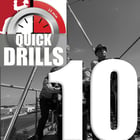 Due to their relative simplicity, belay systems rarely see the dedicated training that is often given to the other elements of rescue, such as mechanical advantage or patient packaging. Just because you can rig a 540 Belay Device or tie a Munter Hitch does not necessarily mean you are proficient in their use.
Due to their relative simplicity, belay systems rarely see the dedicated training that is often given to the other elements of rescue, such as mechanical advantage or patient packaging. Just because you can rig a 540 Belay Device or tie a Munter Hitch does not necessarily mean you are proficient in their use.
It is important that the belayer can choose the proper belay system for the anticipated load and situation as well as understand the pros and cons of each system. Rescue teams must also be able to properly rig the system, troubleshoot any problems that might arise, catch the load and be able to safely transition from the "catch" to an emergency lowering system, if needed.
There is a certain degree of finesse and anticipation involved with efficient belaying. It is an important skill only acquired through practice. Allotting more time to belay-specific training will provide payoff in smoother, safer operations during your next rescue.
1. As a team, discuss the belay needs of your environment (type of device or hitch, need for confined space rigging, high-point/low-point usage, one-person/two-person loads, etc.).
2. Divide your team into pairs and have each pair rig a specified device or hitch as a horizontal ground station.
3. While one member operates the device, the other attaches to the working end of the belay line and walks backwards to simulate a moving load. The team member on the line can also simulate a sudden load being applied to the rope at random intervals for the belayer to catch by pulling quickly on the working end of the rope.
4. If using the 540 Belay Device, develop proficiency in releasing a "stuck" load.
5. When using a Munter, work on body/hand position and tying off the Munter with a mule knot and releasing the mule knot while under load.
6. With tandem prusiks, practice converting to a lower system.
7. No matter what device or system, focus on maintaining a steady rate of rope progress through the device, while maintaining the proper amount of slack in the system (maximum 18 inches).
8. Have members switch positions and/or devices as they work on proficiency.
9. If time and training space allow, rig simple lower/haul scenarios where the emphasis will be on belay practice. In these scenarios, focus on the following:
• Communication between the Rescue Master and the Belayer.
• Maintaining the appropriate amount of slack in the belay system (no more than 18 inches).
Efficient belay skills are often taken for granted. Be sure to master the use of these critical, lifesaving systems!
Next in this series: QUICK DRILL #10 - Tripod Quick Drill



 WASHINGTON - Firefighting is urgent and stressful work, and decisions are often made without vital information on the hazards that exist. Recently, a Denver firefighter died after falling 25 feet through a skylight. OSHA's newly revised manual on "Fire Service Features of Buildings" addresses this and many other types of building-related hazards for emergency responders.
WASHINGTON - Firefighting is urgent and stressful work, and decisions are often made without vital information on the hazards that exist. Recently, a Denver firefighter died after falling 25 feet through a skylight. OSHA's newly revised manual on "Fire Service Features of Buildings" addresses this and many other types of building-related hazards for emergency responders.  OSHA reports that two workers are killed every month in trench collapses. Just recently, OSHA cited two contractors following a trench collapse that buried 22-year-old laborer Carlos Moncayo beneath tons of soil and debris at a Manhattan construction site. OSHA found that Moncayo's death could have been prevented if the general contractor and subcontractor had provided cave-in protection for the trench or braced an adjacent section of undermined and unsupported sidewalk. In connection with Moncayo's death, officials from both companies were indicted for manslaughter and other charges in the New York State Supreme Court on Aug. 5.
OSHA reports that two workers are killed every month in trench collapses. Just recently, OSHA cited two contractors following a trench collapse that buried 22-year-old laborer Carlos Moncayo beneath tons of soil and debris at a Manhattan construction site. OSHA found that Moncayo's death could have been prevented if the general contractor and subcontractor had provided cave-in protection for the trench or braced an adjacent section of undermined and unsupported sidewalk. In connection with Moncayo's death, officials from both companies were indicted for manslaughter and other charges in the New York State Supreme Court on Aug. 5. Rescue Team Calumet – Superior, WI
Rescue Team Calumet – Superior, WI Rescue Team Exxon Plastics – Baton Rouge, LA
Rescue Team Exxon Plastics – Baton Rouge, LA Rescue Team Lion Oil – El Dorado, AR
Rescue Team Lion Oil – El Dorado, AR Rescue Team Shell-Geismar – Geismar, LA
Rescue Team Shell-Geismar – Geismar, LA Rescue Team Valero – Wilmington, CA
Rescue Team Valero – Wilmington, CA Rescue Team Motiva-Convent – Convent, LA
Rescue Team Motiva-Convent – Convent, LA Challenge Evaluators with Kay Goodwyn, Roco’s president
Challenge Evaluators with Kay Goodwyn, Roco’s president













